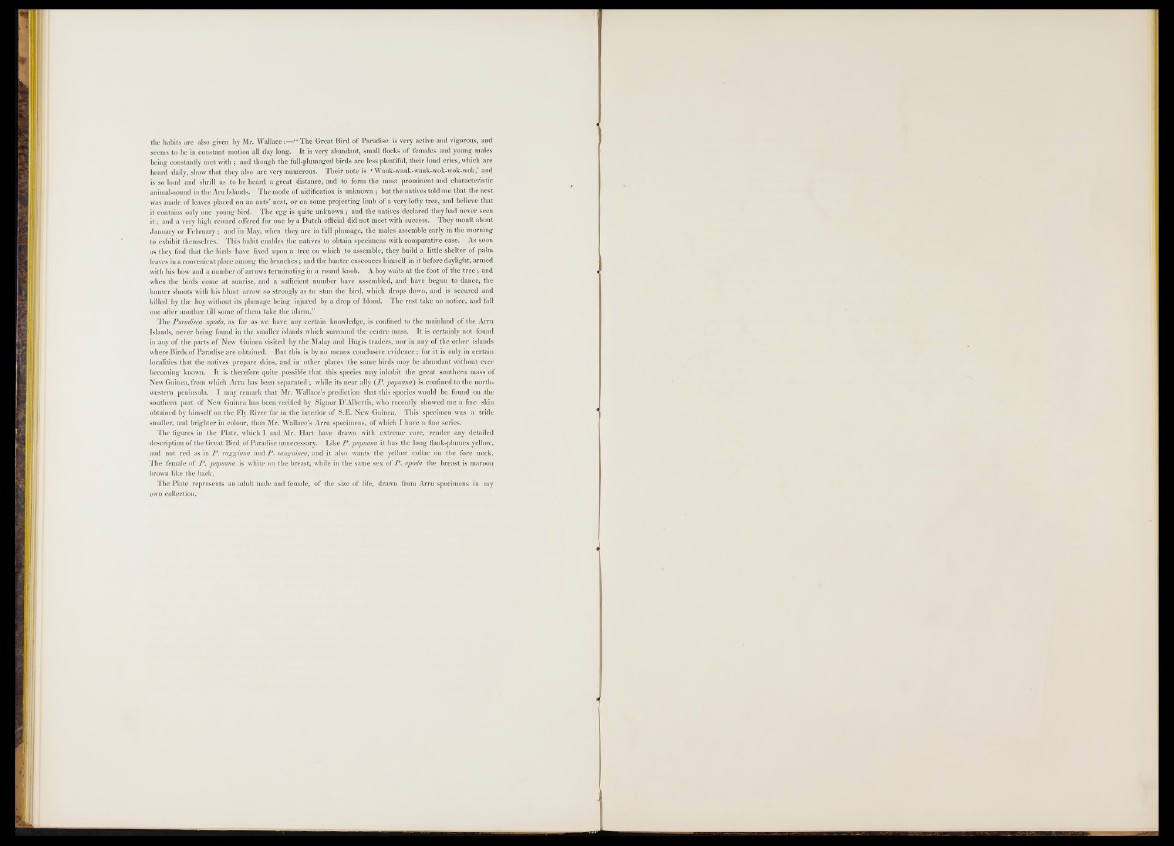
the habits are also given by Mr. Wallace:—“ The Great Bird o f Paradise is very active and vigorous, and
seems to be in constant motion all day long. It is very abundant, small flocks o f females and young males
being constantly met with ; and though the full-plumaged birds are less plentiful, their loud cries, which are
heard daily, show that they also are very numerous. Their note is ‘ Wauk-wauk-wauk-wok-wok-wok,’ and
is so loud and shrill as to be heard a great distance, and to form the most prominent and characteristic
animal-sound in the Aru Islands. The mode of nidification is unknown ; but the natives told me that the nest
was made of leaves placed on an ants’ nest, or on some projecting limb of a very lofty tree, and believe that
it contains only one young bird. The egg is quite unknown ; and the natives declared they had never seen
i t ; and a very high reward offered for one by a Dutch official did not meet with success. They moult about
January or February; and in May, when they are in full plumage, the males assemble early in the morning
to exhibit themselves. This habit enables the natives to obtain specimens with comparative ease. As soon
as they find that the birds have fixed upon a tree on which to assemble, they build a little shelter o f palm
leaves in a convenient place among the branches; and the hunter ensconces himself in it before daylight, armed
with his bow and a number o f arrows terminating in a round knob. A boy waits at the foot o f the tr e e ; and
when the birds come at sunrise, and a sufficient number have assembled, and have begun to dance, the
hunter shoots with his blunt arrow so strongly as to stun the bird, which drops down, and is secured and
killed by the boy without its plumage being injured by a drop o f blood. The rest take no notice, and fall
one after another till some o f them take the alarm.”
The Paradisea apoda, as far as we have any certain knowledge, is confined to the mainland o f the Arru
Islands, never being found in the smaller islands which surround the ceutre mass. It is certainly not found
in any of the parts o f New Guinea visited by the Malay and Bugis traders, nor in any o f the other islands
where Birds of Paradise are obtained. But this is by no means conclusive evidence; for it is only in certain
localities that the natives prepare skins, and in other places the same birds may be abundant without ever
becoming known. It is therefore quite possible that this species may inhabit the great southern mass of
New Guinea, from which Arru has been separated ; while its near ally (P . papuana) is confined to the northwestern
peninsula. I may remark that Mr. Wallace’s prediction that this species would be found on the
southern part o f New Guinea has been verified by Signor D’Albertis, who recently showed me a fine skin
obtained by himself on the Fly River far in the interior o f S.E. New Guinea. This specimen was a trifle
smaller, and brighter in colour, than Mr. Wallace’s Arru specimens, o f which I have a fine series.
The figures in the Plate, which I and Mr. Hart have drawn with extreme care, render any detailed
description o f the Great Bird o f Paradise unnecessary. Like P . papuana it has the long flank-plumes yellow,
and not red as in P . raggiana and P . sanguinea, and it also wants the yellow collar on the fore neck.
The female o f P . papuana is white on the breast, while in the same sex o f P . apoda the breast is maroon
brown like the hack.
The Plate represents an adult male and female, of the size o f life, drawn from Arru specimens in my
own collection.